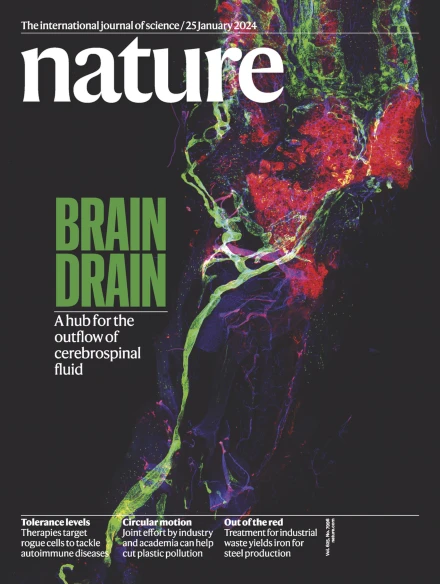CHIT1-positive microglia drive motor neuron ageing in the primate spinal cord
IF 50.5
1区 综合性期刊
Q1 MULTIDISCIPLINARY SCIENCES
引用次数: 0
Abstract
Ageing is a critical factor in spinal-cord-associated disorders1, yet the ageing-specific mechanisms underlying this relationship remain poorly understood. Here, to address this knowledge gap, we combined single-nucleus RNA-sequencing analysis with behavioural and neurophysiological analysis in non-human primates (NHPs). We identified motor neuron senescence and neuroinflammation with microglial hyperactivation as intertwined hallmarks of spinal cord ageing. As an underlying mechanism, we identified a neurotoxic microglial state demarcated by elevated expression of CHIT1 (a secreted mammalian chitinase) specific to the aged spinal cords in NHP and human biopsies. In the aged spinal cord, CHIT1-positive microglia preferentially localize around motor neurons, and they have the ability to trigger senescence, partly by activating SMAD signalling. We further validated the driving role of secreted CHIT1 on MN senescence using multimodal experiments both in vivo, using the NHP spinal cord as a model, and in vitro, using a sophisticated system modelling the human motor-neuron–microenvironment interplay. Moreover, we demonstrated that ascorbic acid, a geroprotective compound, counteracted the pro-senescent effect of CHIT1 and mitigated motor neuron senescence in aged monkeys. Our findings provide the single-cell resolution cellular and molecular landscape of the aged primate spinal cord and identify a new biomarker and intervention target for spinal cord degeneration. Motor neuron senescence and neuroinflammation with microglial hyperactivation are intertwined hallmarks of spinal cord ageing.

CHIT1阳性小胶质细胞驱动灵长类动物脊髓运动神经元老化
老龄化是脊髓相关疾病的一个关键因素1,但人们对这种关系的老龄化特异性机制仍然知之甚少。为了填补这一知识空白,我们将单核 RNA 序列分析与非人灵长类动物(NHPs)的行为学和神经生理学分析相结合。我们发现运动神经元衰老和神经炎症与小胶质细胞过度激活是脊髓老化的交织特征。作为一种潜在的机制,我们发现了一种神经毒性小胶质细胞状态,其特征是在 NHP 和人类活组织样本中,老化脊髓特有的 CHIT1(一种分泌型哺乳动物几丁质酶)表达升高。在衰老脊髓中,CHIT1 阳性的小胶质细胞优先定位在运动神经元周围,它们有能力触发衰老,部分是通过激活 SMAD 信号。我们使用多模式实验进一步验证了分泌型 CHIT1 对运动神经元衰老的驱动作用,这些实验既包括使用 NHP 脊髓作为模型的体内实验,也包括使用模拟人类运动神经元-微环境相互作用的复杂系统的体外实验。此外,我们还证明了抗坏血酸(一种老年保护化合物)可以抵消 CHIT1 的促衰老效应,减轻老龄猴运动神经元的衰老。我们的研究结果提供了老龄灵长类动物脊髓的单细胞分辨率细胞和分子图谱,并确定了脊髓变性的新生物标志物和干预目标。运动神经元衰老和神经炎症与小胶质细胞亢进是脊髓老化相互交织的标志。
本文章由计算机程序翻译,如有差异,请以英文原文为准。
求助全文
约1分钟内获得全文
求助全文
来源期刊

Nature
综合性期刊-综合性期刊
CiteScore
90.00
自引率
1.20%
发文量
3652
审稿时长
3 months
期刊介绍:
Nature is a prestigious international journal that publishes peer-reviewed research in various scientific and technological fields. The selection of articles is based on criteria such as originality, importance, interdisciplinary relevance, timeliness, accessibility, elegance, and surprising conclusions. In addition to showcasing significant scientific advances, Nature delivers rapid, authoritative, insightful news, and interpretation of current and upcoming trends impacting science, scientists, and the broader public. The journal serves a dual purpose: firstly, to promptly share noteworthy scientific advances and foster discussions among scientists, and secondly, to ensure the swift dissemination of scientific results globally, emphasizing their significance for knowledge, culture, and daily life.
 求助内容:
求助内容: 应助结果提醒方式:
应助结果提醒方式:


